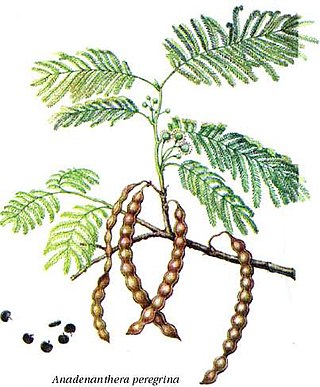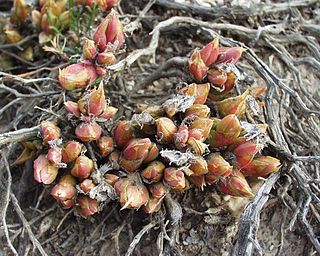
Serotonin or 5-hydroxytryptamine (5-HT) is a monoamine neurotransmitter. Its biological function is complex and multifaceted, modulating mood, cognition, reward, learning, memory, and numerous physiological processes such as vomiting and vasoconstriction. Approximately 90% of the serotonin the human body produces is in the gastrointestinal tract's enterochromaffin cells, where it regulates intestinal movements.

Tryptophan is an α-amino acid that is used in the biosynthesis of proteins. Tryptophan contains an α-amino group, an α-carboxylic acid group, and a side chain indole, making it a polar molecule with a non-polar aromatic beta carbon substituent. Tryptophan is also a precursor to the neurotransmitter serotonin, the hormone melatonin, and vitamin B3. It is encoded by the codon UGG.

Anadenanthera peregrina, also known as yopo, jopo, cohoba, parica or calcium tree, is a perennial tree of the genus Anadenanthera native to the Caribbean and South America. It grows up to 20 m (66 ft) tall, and has a horny bark. Its flowers grow in small, pale yellow to white spherical clusters resembling Acacia inflorescences. It is an entheogen which has been used in healing ceremonies and rituals for thousands of years in northern South America and the Caribbean. Although the seeds of the yopo tree were originally gathered from the wild, increased competition between tribes over access to the seeds led to it being intentionally cultivated and transported elsewhere, expanding the plant's distribution through introduction to areas beyond its original native range.

5-Hydroxytryptophan (5-HTP), also known as oxitriptan, is a naturally occurring amino acid and chemical precursor as well as a metabolic intermediate in the biosynthesis of the neurotransmitter serotonin.

Carbidopa (Lodosyn) is a drug given to people with Parkinson's disease in order to inhibit peripheral metabolism of levodopa. This property is significant in that it allows a greater proportion of administered levodopa to cross the blood–brain barrier for central nervous system effect, instead of being peripherally metabolised into substances unable to cross said barrier.

Mimosa tenuiflora, syn. Mimosa hostilis, also known as jurema preta, calumbi (Brazil), tepezcohuite (México), carbonal, cabrera, jurema, black jurema, and binho de jurema, is a perennial tree or shrub native to the northeastern region of Brazil and found as far north as southern Mexico, and the following countries: El Salvador, Honduras, Panama, Colombia and Venezuela. It is most often found in lower altitudes, but it can be found as high as 1,000 m (3,300 ft).

Nabiximols is a specific Cannabis extract that was approved in 2010 as a botanical drug in the United Kingdom. Nabiximols is sold as a mouth spray intended to alleviate neuropathic pain, spasticity, overactive bladder, and other symptoms of multiple sclerosis; it was developed by the UK company GW Pharmaceuticals. In 2019, it was proposed that following application of the spray, nabiximols is washed away from the oral mucosa by the saliva flow and ingested into the stomach, with subsequent absorption from the gastro-intestinal tract. Nabiximols is a combination drug standardized in composition, formulation, and dose. Its principal active components are the cannabinoids: tetrahydrocannabinol (THC) and cannabidiol (CBD). Each spray delivers a dose of 2.7 mg THC and 2.5 mg CBD.

Mesembryanthemum tortuosum is a succulent plant in the family Aizoaceae native to the Cape Provinces of South Africa. It is known as kanna, channa, kougoed —which literally means, 'chew(able) things' or 'something to chew'.

The International Exposition of 1867 was the second world's fair to be held in Paris, from 1 April to 3 November 1867. A number of nations were represented at the fair. Following a decree of Emperor Napoleon III, the exposition was prepared as early as 1864, in the midst of the renovation of Paris, marking the culmination of the Second French Empire. Visitors included Tsar Alexander II of Russia, a brother of the King William and Otto von Bismarck of Prussia, Prince Metternich and Franz Josef of Austria, Ottoman Sultan Abdülaziz, and the Khedive of Egypt Isma'il.

The genus Tylosema is in the plant family Fabaceae and encompasses four accepted species of perennial legumes native to southern and central Africa. These are semi-woody viniferous plants broadly distributed from Sudan and Ethiopia south to Angola and South Africa. Coetzer and Ross originally described four Tylosema species:

Tryptophan hydroxylase (TPH) is an enzyme (EC 1.14.16.4) involved in the synthesis of the neurotransmitter serotonin. Tyrosine hydroxylase, phenylalanine hydroxylase, and tryptophan hydroxylase together constitute the family of biopterin-dependent aromatic amino acid hydroxylases. TPH catalyzes the following chemical reaction
Cardiac fibrosis commonly refers to the excess deposition of extracellular matrix in the cardiac muscle, but the term may also refer to an abnormal thickening of the heart valves due to inappropriate proliferation of cardiac fibroblasts. Fibrotic cardiac muscle is stiffer and less compliant and is seen in the progression to heart failure. The description below focuses on a specific mechanism of valvular pathology but there are other causes of valve pathology and fibrosis of the cardiac muscle.

Senna alexandrina is an ornamental plant in the genus Senna. It is used in herbalism. It grows natively in upper Egypt, especially in the Nubian region, and near Khartoum (Sudan), where it is cultivated commercially. It is also grown elsewhere, notably in India and Somalia.

CP-94253 is a drug which acts as a potent and selective serotonin 5-HT1B receptor agonist, with approximately 25x and 40x selectivity over the closely related 5-HT1D and 5-HT1A receptors. It has a range of behavioral effects, based on animal testing. The effects include the following: promoting wakefulness by increasing dopamine release in the brain; reducing food intake and promoting satiety; enhancing the reinforcing effects of cocaine; and possible antidepressant effects. A recent study found that "Regardless of sex, CP94253 decreased cocaine intake after abstinence and during resumption of SA [self-administration] and decreased cue reactivity" suggesting that agonism of the inhibitory 5-HT2B receptors may diminish the cognitive reward of cocaine usage and increased use of the drug without a period of abstinence may be a product of test subjects trying to achieve a previously rewarding experience through larger dosages of cocaine.

Griffonia is a genus of central African flowering plants in the legume family, Fabaceae. It belongs to the subfamily Cercidoideae. Griffonia is known to have a high concentration of 5-HTP in its seeds.

Millettia pachycarpa is a perennial climbing shrub belonging to the genus Millettia. It is one of the most well-known among ~150 species of Millettia, as it is widely used in traditional practices, such as for poisoning fish, agricultural pesticide, blood tonic, and treatments of cancer and infertility. The bark fiber is used for making strong ropes.

Strophanthus hispidus, the hispid strophanthus, is a liana or shrub that can grow up to 5 metres (16 ft) tall. Its flowers feature a yellow corolla and yellow corona lobes spotted with red, purple or brown. The seeds, like those of several other Strophanthus species, contain potent cardiac glycosides absorbable through wounds - hence its use in African arrow poisons and later in modern medicine as a digitalis-like heart stimulant. Strophanthus hispidus is native from west tropical Africa east to Tanzania and south to Angola. It is naturalized in China.

N-Feruloylserotonin an alkaloid and polyphenol found in safflower seed. Chemically, it is an amide formed between serotonin and ferulic acid. It has in vitro anti-atherogenic activity.

Marie-Théophile Griffon du Bellay was a French physician, naval surgeon, explorer and ethnobotanist.

Monoamine precursors are precursors of monoamines and monoamine neurotransmitters in the body. The amino acids L-tryptophan and L-5-hydroxytryptophan are precursors of serotonin and melatonin, while the amino acids L-phenylalanine, L-tyrosine, and L-DOPA (levodopa) are precursors of dopamine, epinephrine (adrenaline), and norepinephrine (noradrenaline). Administration of monoamine precursors can increase the levels of monoamine neurotransmitters in the body and brain. Monoamine precursors may be used in combination with peripherally selective aromatic L-amino acid decarboxylase inhibitors such as carbidopa and benserazide. Carbidopa/levodopa is used to increase brain dopamine levels in the treatment of Parkinson's disease while carbidopa/oxitriptan (EVX-101) is under development as an antidepressant for possible use in the treatment of depression.


















